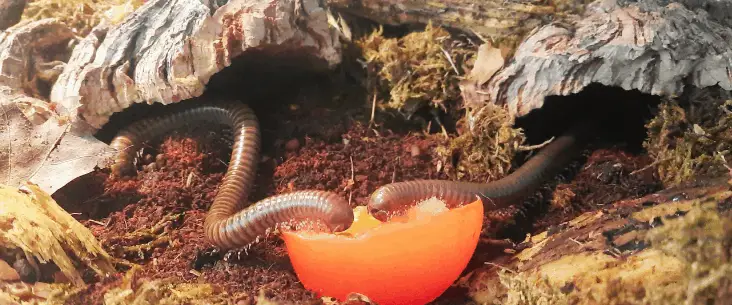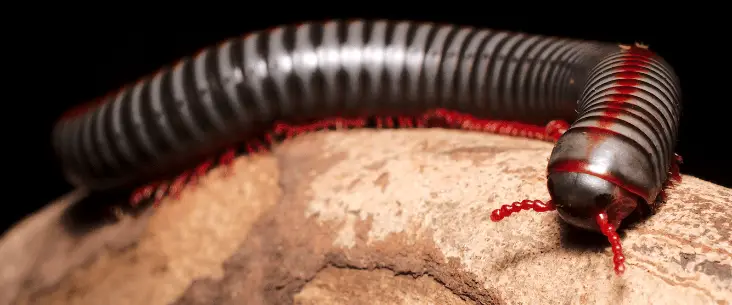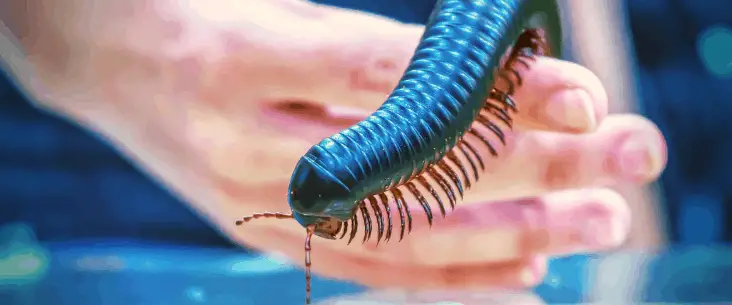If you found this article, you probably ask yourself if you can keep millipedes together with other animals. I asked myself the same a few years ago. Although there is some information out there, I still wanted to test if the combination of different species together with millipedes would be successful. Combining different species in one enclosure is called ‘communal setup‘ or ‘mixed-species exhibit‘. This article will discuss if you can keep millipedes with different other animals in a communal setup.
You can successfully keep millipedes together with isopods, beetles, snails and cockroaches if you provide enough living room for each species, and the needed living conditions are more or less the same for each species. You can also combine millipedes with species that live in another layer in the enclosure, like stick insects, for example.
Several different combinations can be very successful and increase the diversity and activity in your enclosure. In other words, it is more interesting to look at your enclosure with more different species in it. Millipedes are not always the most active pet species, and they often hide in the substrate. However, you can’t just add species together without considering some important aspects. We will discuss how you can best combine different animals with millipedes in one enclosure and talk about which combinations have proven successful.
Can millipedes live together with… some important notes
First, I like to make some important notes on combining different species in one enclosure. There are some things to think about. Every animal has its own needs. If you have already a couple of millipedes you know they need a certain enclosure space and like to have a good layer of a substrate. Many millipedes are best to keep a bit warmer than room temperature by using a heat lamp or heating pad.
But what about the other species? There are three aspects you need to consider!
When you want to combine different species in one enclosure, you often need a large(r) enclosure — like you do when keeping more individuals of the same species. Although this seems obvious, it is not always done or thought of.
A good rule of thumb is to use the largest species’ surface requirements and multiply it by 1½. For example, if your primary or largest animal needs 12″ x 12″ x 12″ (30cm x 30cm x 30cm), you now need an enclosure that is 18″ x 18″ x 18″(45cm x 45cm x 45cm).
For millipedes, the surface is important, but for some species (like stick insects), the height is more important. Then, you don’t need to increase the surface of the enclosure but need a higher enclosure.
You can only combine species that have the same climate requirements like temperature, humidity and light. They don’t need to be exactly the same, but at least the optimal ranges for both (or all species) need to have an overlap.
For example, you can’t combine a species that likes to have it dry and hot together with (most) millipedes. Millipedes like to have a humid substrate and to be kept just above room temperature.
Although it seems easy when both species eat the same food, it can cause food competition. When combining different species, it is easier to search for species with other dietary preferences (as long as it is not each other).
If you have species that eat from the same food source, you need to provide it in larger quantities and at multiple locations in the enclosure. That way, animals can avoid each other and don’t have to compete for food.
You should also consider that some species won’t eat each other as adults, but one can predate youngs, hatchlings or eggs of the other. To some degree, that is not a problem, but eventually, one species will push away the other species (for example, when one species will have more breeding success and rise in numbers).
Recommended read: How to make your garden a home for insects with 9 practical tips.
When the above is taken into consideration, it is now time to discuss the different combinations of species. Communal setups are great and exciting to have, and it provides a good challenge for the ones that like an interesting combination. First, let’s look at combining millipedes with… other millipedes!
Can you keep millipedes together with other millipedes
A question that I often get is if you can combine different species of millipedes together. There are many millipedes that are available in the pet industry, and one is even more coloured and beautiful than the other. No wonder that people like to keep multiple species together, but not everyone wants to have too many enclosures. So why not place them in one enclosure.
Combining different millipedes can be very successful. Because most millipedes thrive in the same requirement and have more or less the same needs, they can easily be housed together. They eat only organic matter and won’t compete on food if you have provided them with enough substrate and fruit & vegetables.
Suppose you like to know more about combining different millipedes species, I recommend you to read the article dedicated to the keeping of different millipedes. It talks in-depth about the best practice and all that you need to consider.
Recommended read: Can you keep different millipede species together?
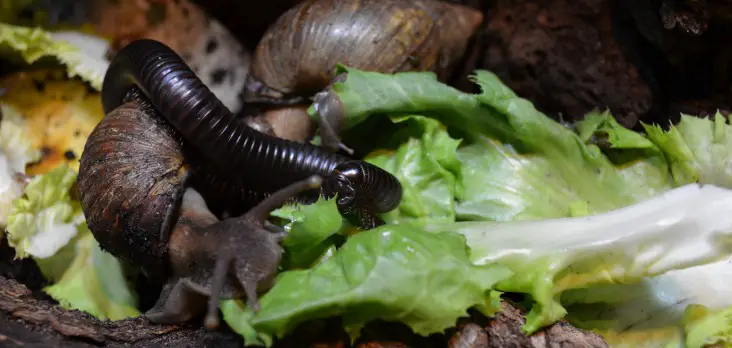
Can you keep millipedes together with snails
Can you keep millipedes together with snails? Yes! Snails are perfect buddies for millipedes. They thrive very well, and both are slow-moving, peacefully munching on organic matter (although snails always need fresh vegetables).
The giant African snails work really well with millipedes. They don’t compete for food, both thrive in the same environment, and both don’t reproduce that quickly. Over time the snails can get with too many, and you probably need to get rid of some. But because of their slow reproduction rate, your enclosure won’t get overcrowded quickly.
I’ve kept snails with millipedes for over 10 years without any problem at all.
Can you keep millipedes together with isopods
Can you keep millipedes and isopods together? Isopods are not good roommates for millipedes. Although there are some anecdotal stories that this combination worked, generally, isopods and millipedes can’t be housed together.
Isopods eat almost anything and will eat millipedes eggs, newly hatched millipedes and even nibble on adult millipedes (especially when they just moulted). There are reports that they have been seen eating adult millipedes, but it is not sure they already died before they feast on them.
But above is enough reasons not to take the risk. There are many other combinations that work really well, so don’t try to combine isopods with millipedes.
Can you keep millipedes together with cockroaches
Millipedes and cockroaches — can they be housed together. At the basics, they can, but there is a big BUT. First, they can thrive in the same environment. They don’t need another climate or furniture to be both happy.
But let’s make it clear from the start, although you can keep them together, it is not a favourable combination. Many cockroaches will reproduce rather quickly. Think of dubia roaches or red runners. That is the reason they are often used for breeding as feeder insects. So you can only try to combine them with slow reproducing cockroaches, with are mostly the larger hissers (Madagascar hissing cockroaches, for example).
But even with slow reproducing cockroaches, there are several challenges. Cockroaches can and may nibble on young or recently moulted millipedes. When they do, they damage the millipede, which (eventually) will die. But even when that is not the case, cockroaches may stress your millipedes.
Millipedes need some place to rest and be on their own, especially when it is time to moult. So they regular or continuously disturbed by cockroaches, which are much more active than millipedes. The stress it causes will harm your millipedes. It can result in bad moults, lower reproduction and premature death.
Therefore I don’t recommend keeping millipedes and cockroaches together in one enclosure unless it is a huge enclosure and the number of cockroaches is heavily controlled.
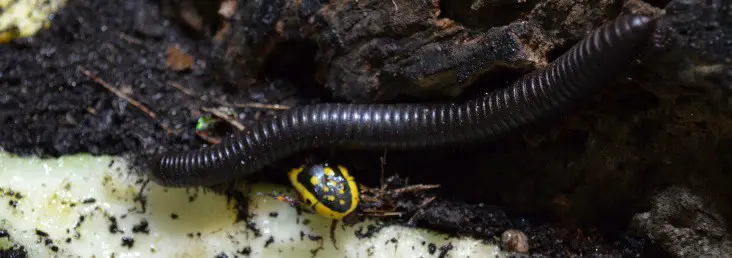
Can you keep millipedes together with beetles
Beetles are one of the most successful insect family in the world. And I will say it right from the start: you can only combine flower beetles with millipedes. Why? Because stag and rhinoceros beetles are strong and solitary living beetles. Besides, you won’t have much success with breeding these species of beetles when combining them with other animals like millipedes.
However, flower beetles are there in many different species, and they can be kept with millipedes rather successful. I’ve kept different species of flower beetles with millipedes without many problems. Especially sun beetles work really well with them.
But there are a few things you need to look out for. First, you need much more floor space and much more volume of substrate in your enclosure. Both millipedes and flower beetles munch on decaying organic matter and live completely on and in the substrate. To prevent competition, it is important to have enough good quality substrate. You also need to provide enough supplemental food sources like fruits and vegetables.
Because flower beetles can produce much faster than millipedes, you eventually need to decrease the flower beetle population in the enclosure. If you have too much flower beetle larvae, the nutrition in the substrate will run out rather quickly, and larvae can eventually eat millipede eggs or newly hatched millipedes. Be aware, this will always happen to some minor degree, but with enough room, substrate and population control, it won’t affect your millipede population.
One thing to consider is that flower beetles (the adults) need much more vertical space. Adult flower beetles will climb and fly towards the light and therefore need room to do so.
But overall, flower beetles are good roommates for your millipedes. And with the amazing colours flower beetles often have, it is exciting to watch the activity in your enclosure.
Can you keep millipedes together with stick insects
Can you keep millipedes together with stick insects? It is a more unusual combination, but it can work. This is a good example of combining two species that live in another layer of the enclosure: millipedes will live mostly on and in the substrate, while stick insects will thrive in the enclosure’s higher ends.
First, you can only combine stick insects that live in the same type of environment — with other words that need the same temperature and humidity as millipedes. However, many stick insect species are happy with those parameters. It would be best if you have an enclosure that is much higher than normally millipedes need. An enclosure of 24″ (60cm) or higher is recommended.
Next, you need stick insects that mostly stay up high and don’t walk much on the bottom floor. Stick insects are fragile creatures, and millipedes can damage thin stick insects that walk on the substrate. However, if you choose a more bulkier stick insect, than that wouldn’t be much of a problem.
One thing to consider is that it is not recommended to choose stick insects that bury their eggs in the substrate. Because millipedes burrow and stir up the substrate, eggs may end up on the substrate and dry out. The best would be to have stick insects that glue or pierce their eggs onto leaves and stems. That way, you don’t have to worry that millipedes disturb or damage the eggs.
Combining stick insects and millipedes is not often seen in the hobby of keeping insects, but it is a combination that can work really well.
Can you keep millipedes together with dart frogs
I’ve had this question several times over the last year. Can you keep millipedes together with dart frogs? At least, I need to say it is an unusual combination to have. However, because of the environment where dart frogs live, it is not most suitable for millipedes.
Although it tends not to be a problem initially, millipedes may (however I think they eventually will) nibble on the plants that are often offered to dart frogs. Especially the roots of plants in the ground will have it difficult to grow and thrive.
Also, millipedes will munch on many things that are on and in the substrate, and frog eggs won’t be safe for millipedes because they will eat (at least some of) them. That’s a shame because it is nice to breed with your frogs as well.
Lastly, millipedes won’t show themselves much because millipedes do not like the high light intensity needed for frog vivariums. During the day, millipedes will find shelter and are burrowed in the substrate.
To summarize: yes, you can keep millipedes with dart frogs (based on anecdotal case reports), but it is not the highest recommended combination to try out. There are much better roommates for your millipedes, where both species thrive better and more easily.
Want to know more about millipedes?
Are you new to keeping millipedes or want to know more about the care for millipedes, I like to recommend you to read the basic guide of keeping and caring for millipedes.
The substrate is one of the most important aspects when keeping millipedes. Therefore I dedicated a special guide on the best way to apply the substrate to your millipedes in this millipede substrate guide. Head over and learn more about the millipede substrate.
Share this page!

